Last Updated on January 27, 2024 by Greg Gillson
What birds come to feeders in Kentucky?
This article discusses the most common birds at bird feeders in Kentucky throughout the year. Other feeder birds may be more common seasonally, but these should be present most of the year.
I start with a quick list of Kentucky feeder birds and then provide more information if you are so interested.
Feeding birds in Kentucky can bring much joy!
Here are 10 birds that you are most likely to see at your bird feeder in Kentucky:
- Northern Cardinal
- Blue Jay
- Mourning Dove
- Carolina Chickadee
- Tufted Titmouse
- European Starling
- Red-bellied Woodpecker
- American Goldfinch
- Downy Woodpecker
- Song Sparrow
Northern Cardinal
The most common feeder bird in Kentucky is the Northern Cardinal. Read more about it, below.
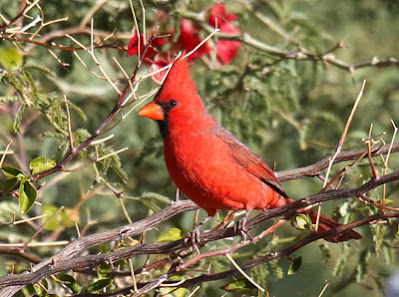 |
| Northern Cardinal. Greg Gillson. |
Northern Cardinals are one of the most popular birds in the United States. Even people who haven’t seen one in life have seen their image on logos and advertisements.
These birds are year-round residents from the northeastern United States south to Florida, west to the Midwest, southern Great Plains to Arizona.
They are found in woodlands, hedgerows, and dense backyard shrubs.
Both males and females sing, a series of repeated whistles.
These birds are less bulky than European Starlings, but just as long. The have a very long tail and big head with tall crest.
The bill is very thick at the base, short, with curved edges. It is usually obviously orange.
Males are bright red throughout, with hints of blue on the wings, tail, and back. They have a black throat patch that reaches to the eye and over the bill.
Females are dull brown or buffy yellow in coloration with red highlights on the edges of the wings and tail. Their crest isn’t quite as pronounced as the males. They still show the black around the bill.
Northern Cardinals eat larger seeds at your feeder, including black oil sunflower seeds and safflower seeds.
American Goldfinch
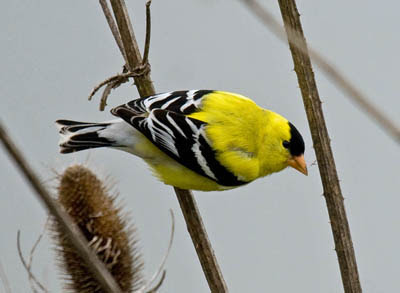 |
| American Goldfinch. Greg Gillson |
The American Goldfinches are favorite backyard birds across North America. Many people call them “wild canaries.”
These active birds are year-round residents coast-to-coast across northern and mid-latitudes of the United States.
In summer birds move into southern Canada. In winter birds are found throughout the United States.
They are found in weedy pastures and brushy clearings. In town, they favor parks and residential areas with lawns and scattered trees. They often feed on thistles or dandelion seeds on the ground. But they also fly over open spaces between trees with a bounding roller-coaster flight and a lilting “potato chip” call.
These are small birds, smaller than House Finches. They are rather plump birds with small round heads and short tails. The bill is small but it is conical for eating seeds. It is colored pink.
Summer males are striking with their brilliant yellow and black plumage. The body is yellow and they have a black crown. The wings and tail feathers are black and white.
Females are duller olive-green without the black crown. They have thin white wing bars.
Juvenile birds in fall show striking tan wing bars on the black wing.
In winter both genders are pale gray and tan with brown wings and tail. They may only show a hint of yellow on the head and throat.
At your feeder, American Goldfinches love black oil sunflower seeds and Niger seed. They are especially common at feeders in summer and fall.
Mourning Dove
 |
| Mourning Dove. Greg Gillson |
The mournful summer song of Mourning Doves is familiar to most, even if they don’t know what bird makes the sound.
They are found across the United States as year-round residents. Birds summer in the northern Great Plains and south central Canada, but withdraw in winter.
These birds are found in towns and farms, and open country with scattered trees, often along rivers.
In spring they sing from power lines in residential areas. They may puff out their chests while cooing from the peak of your roof.
These birds are much larger than European Starlings, but also much smaller than American Crows. These birds have large powerful breasts, a tiny round head on thin neck, and long pointed tail. Their wings are somewhat pointed in flight. The bill is small as typical for all pigeons. Genders are identical.
These birds are warm tan or brown colored. The breast has a pinkish hue. The wings are gray. They have a few large black spots on the wing coverts. They have a black spot on the side of the neck below the cheek that sometimes shows some iridescent green feathers. The tail has white edges, best seen in flight.
At your bird feeder Mourning Doves eat all types of seeds. They are also attracted to water for drinking and bathing.
Downy Woodpecker
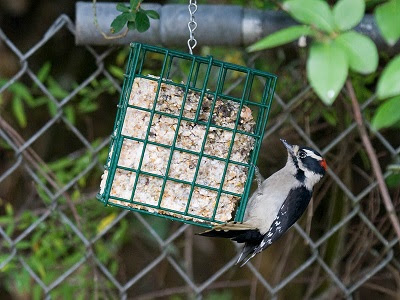 |
| Downy Woodpecker. Greg Gillson |
Downy Woodpeckers are tiny and common visitors to backyards across the United States.
These woodpeckers inhabit nearly all of North America south of the tundra and away from the driest deserts.
Often found near water, they like small deciduous trees, willows, and brush. Common in backyards.
Like other woodpeckers, these birds hitch up small trees. However, they often cling to the small outer branches. They even hang on twigs and small bushes such as wild rose and teasel.
They are bigger than House Finches, smaller than Red-winged Blackbirds, but shaped differently than either. These birds have stocky bodies and big heads. They have short, stiff, pointed tails. The legs are short. The feet are large with strong claws. The bills of these woodpeckers are chisel shaped but especially short and petite.
The overall pattern of these birds is black-and-white stripes. The wings are black with numerous white spots and bars. The back is white. The underparts are white or tinged with buff. The face is white; the crown and nape is black, the ear covert black, and there is a black malar stripe. The tail is black with white outer tail feathers. Males have a red spot on the nape that females lack.
Downy Woodpeckers eat suet at your feeder.
Blue Jay
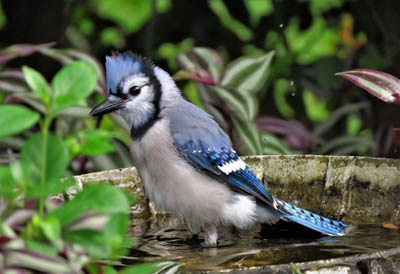 |
| Blue Jay. skeeze Pixabay |
Blue Jays are one of the most well-known birds in the United States.
Birds are found year-round east of the Rocky Mountains from southern Canada to Texas and eastward. There is a noticeable migration of some of their population in most of their range. Birds move northward into the Great Plains of Canada for the summer.
Though they are found in woodlands of all type, they are especially attracted to oak trees. They are common in residential areas, too.
Brash and conspicuous, Blue Jays have a complex social structure. The more the crest is raised, the more excited or agitated the bird is.
Jays are fairly large backyard birds. They are just a bit larger than American Robins. These are stout birds with large rounded or wedge-shaped tails. They have large legs and feet. They have a bushy crest. The bill is fairly long, strong.
Genders are similar in plumage. They are blue above, including the crest. They are gray below with a black necklace across the throat. The wings are barred with black, with white wing bars and trailing edges. The blue tail is barred with black and has white tail corners.
At your feeder, Blue Jays love whole peanuts and sunflower seeds.
Red-bellied Woodpecker
 |
| Red-bellied Woodpecker. skeeze. Pixabay |
Red-bellied Woodpeckers are one of the common woodland birds in the East.
These birds are year-round residents from the Northeast to the Midwest, and south from Florida to eastern Texas.
They aren’t too picky in their choice of trees. They are found in deciduous and conifer forests. They may be found in parks and neighborhoods with mature trees. Learn and listen for the loud rolling churr call of these woodpeckers. You may find they are more common than you first thought.
These birds are a bit larger than European Starlings. They a stocky with large head and short wedge-shaped tail. The bill is long, straight. and chisel shaped.
The upper parts, including the back and wings are covered with thin black-and-white bars. The head and under parts are pale tan or gray. They have white rumps and black tails with barred outer tail feathers.
Males have red crowns from their bill to their back. Some also show a reddish wash to their belly.
Females have red crowns from the top of their head back, with gray fore-crowns.
At feeders, Red-bellied Woodpeckers love suet, and also eat peanuts.
Tufted Titmouse
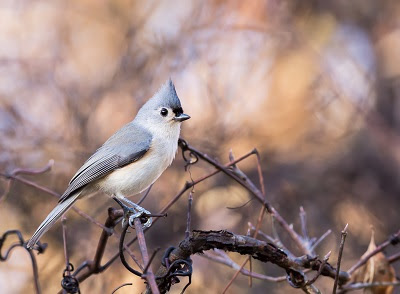 |
| Tufted Titmouse. N Lewis. NPS. |
Tufted Titmice are one of the favorite feeder birds in the East.
They are year-round residents from the Northeast to the Midwest and south to Florida and eastern Texas.
These birds like deciduous and mixed woods. They are found in parks, orchards, and residential areas with large trees.
They are acrobatic as they move through the tree canopy. But you will often hear them first, as they have a wide variety of both husky calls and clear whistled notes.
These birds are nearly the size of House Sparrows. They are larger than chickadees. They have stout bodies and a large head on short neck. The tails are medium in length. The crest is wispy and not always as obvious as one might think. The bill is short and stout.
They are gray above and pale below, often with a pale peach color on the flanks. There are black feathers around the eye, which make the eye look big and stand out on the pale face. There is also a touch of black on the forehead above the bill. Genders are similar in appearance.
Tufted Titmice eat black oil sunflower seeds, peanuts, and suet at your bird feeder.
Song Sparrow
 |
| Song Sparrow. Greg Gillson |
Song Sparrows are widespread across North America.
These birds summer from southern Alaska and across Canada to the Ohio River Valley and in the West to southern California and Arizona. In winter most birds leave Canada and the northern Great Plains, except for a population in western Canada. The winter birds push south to Florida and Texas into northern Mexico.
These birds are found in a wide variety of brushy habitats. They are found in open woodlands, marshes, and backyards landscaped with large bushes and brambles.
They spend a lot of time hopping on the ground looking for food. They eat insects and invertebrates in summer, but mostly seeds in winter.
They are a bit smaller than House Sparrows. They have a round body, round head, and longer tail with a rounded tip. The bill is triangular, short and thick at the base.
Across their range these birds show much variation. Desert birds are paler. Northwestern birds are dark and reddish. Alaskan birds are much larger. In general, they are gray, streaked with brown, with breast streaks forming a center spot on the breast. The pattern of the head is complex but rather diagnostic. The white throat is bordered by a flaring lateral throat stripe. Genders are identical.
Song Sparrows will visit platform feeders, but more likely stay under dense bushes, venturing out on the ground below the feeder.
Carolina Chickadee
 |
| Carolina Chickadee. N Lewis. NPS. |
Carolina Chickadees are small, birds, unafraid to live near humans.
These are permanent residents in the eastern and southeastern United States.
They are found in backyards and deciduous woods.
Active and acrobatic, they frequently hang from the tips of branches to reach insects that other birds miss. In winter they form loose flocks with other small birds, especially including Tufted Titmice.
These are small birds, even smaller than American Goldfinches.
They are round-bodied with a big head on a short neck. The tail is long and active. Bills are small but stout.
They are gray above, paler gray below. The face is white contrasting with black cap and bib. Genders are similar in appearance.
At your feeder, Carolina Chickadees are fond of black oil sunflower seeds.
European Starling
 |
| European Starling. Greg Gillson |
Starlings are often mistaken for blackbirds, but they are in a different bird family and don’t share a lot of similarities, other than a general black coloration.
These birds are year-round residents from southeast Alaska across southern Canada and all of the lower 48 states into northern Mexico. In addition, birds move northward into northern Canada in summer.
They are found in urban, suburban, fields, and orchards. In autumn and winter they gather into huge flocks, often with blackbirds. They are frequently aggressive at feeders, driving off other birds.
These birds have the body size of an American Robin, but a much shorter tail. They are about 8-1/2 inches long from bill tip to tail tip. They have plump bodies, rather large heads, and short tails. Wings are short and pointed in flight, almost triangular. Their bills are long and pointed.
Dark brown worn birds in late summer get fresh new feathers in fall. Then their iridescent black feathers are tipped with white chevrons. These gradually wear off during the winter and spring. By summer they are mostly black, without many spangles.
Breeding birds have yellow bills, the bills are brown in the non-breeding season. Both genders are colored the same.
Because of their aggressive nature, most people do not like starlings at their bird feeders. Starlings have weak feet, so have trouble eating from tube feeders and special upside-down suet feeders.
Recommended Products for feeding birds in Kentucky
The hopper feeder is just the right size and durable. The best high quality mixed bird seed for this bird feeder that I highly recommend is Wagner’s Songbird Supreme. This combination attracts the widest variety of feeder birds.
I really like how this iBorn copper tube feeder looks in my yard. It is best for finches and chickadees when filled with black oil sunflower seed.
For attracting woodpeckers and chickadees, and keeping out jays, starlings, and grackles, I love my Nature’s Way Upside-Down Suet Feeder. I also buy St. Albans Bay suet.
Wrapping Up
Having a backyard bird feeder in Kentucky brings several benefits for both the birds and you:
Benefits for the birds:
- Supplemental food source: Kentucky winters can be harsh, and natural food sources become scarce. Bird feeders provide valuable sustenance for a variety of bird species, especially insectivores like chickadees and nuthatches who struggle to find insects during this time.
- Shelter and refuge: Feeders attract birds looking for safe areas to rest, preen, and socialize. This is especially crucial during extreme weather conditions, offering them a haven from the heat or cold.
- Habitat enhancement: Well-maintained feeders with diverse seed mixes, combined with native plants providing additional food and cover, create mini-habitats that attract diverse bird species, contributing to local biodiversity.
- Educational opportunities: Bird feeders offer a fantastic opportunity to observe and learn about different bird species in your own backyard. This can be a fascinating and educational experience for children and adults alike.
Frequently Asked Questions
What is the most common bird in Kentucky?
Determining the “most common” bird in Kentucky can be tricky, as it depends on how you define “common.” Here are a few different contenders based on different interpretations:
By Abundance:
- Mourning Dove (Zenaida macroura): This abundant dove thrives in various habitats and is frequently seen throughout the state. Their gentle cooing is a familiar sound in Kentucky backyards and fields.
- European Starling (Sturnus vulgaris): Unfortunately, introduced and invasive, European Starlings form large flocks and compete with native birds for food and nesting sites. While widespread and numerous, their presence is not necessarily desirable.
By Sightings:
- Northern Cardinal (Cardinalis cardinalis): Kentucky’s state bird, the vibrant red male cardinals and their melodious songs are beloved residents, making them highly recognizable and frequently seen in both backyards and natural areas.
- House Finch (Haemorhous mexicanus): Another common backyard visitor, House Finches are widespread and readily attracted to feeders, making them familiar sights for many Kentuckians.

What is the state bird of Kentucky?
The state bird of Kentucky is the Northern Cardinal (Cardinalis cardinalis)! This beautiful bird is well-known for its vibrant red plumage in males and its sweet, melodious song. It was officially designated as the state bird in 1926 due to its popularity and widespread presence throughout Kentucky.

What is the bright yellow little bird in Kentucky?
Identifying a specific bird based solely on color can be tricky, but several bright yellow birds reside in Kentucky. To narrow it down, consider these details:
Size: How small is “little”? Sparrow-sized, robin-sized, or somewhere in between? Habitat: Where did you see it? Backyard, forest, wetland, or somewhere else? Behavior: What was it doing? Hopping on the ground, flitting through branches, perched on a feeder, or something else? Distinguishing features: Did you notice any specific markings, patterns, or unique features, like stripes, wing bars, or a long bill?
Here are some bright yellow birds in Kentucky to consider based on these details:
Small, sparrow-sized:
- Yellow Warbler: Has a distinctive black mask and olive wings. Prefers open woodlands and edges of forests.
- Prothonotary Warbler: Smaller, with blue-gray wings and a black patch on the chest. Found in swamps and bottomland forests.
- Kentucky Warbler: Has black head and chest, with bright yellow underparts and yellow “spectacles” around the eyes. Prefers dense undergrowth in forests.
Medium-sized, robin-sized:
- Yellow-throated Vireo: Has a prominent yellow throat and breast, olive-green back, and two bold white wing bars. Found in a variety of habitats, including forests, parks, and backyards.
- American Goldfinch: Male has vibrant yellow body, black wings, and a red bill. Found in open areas, fields, and backyards, especially near thistles and other seed-bearing plants.
Related Articles:
Red, Orange & Yellow Birds in Kentucky










